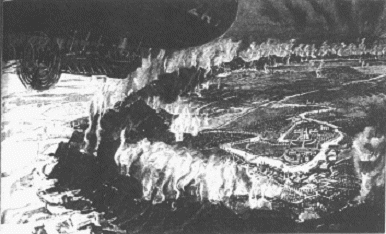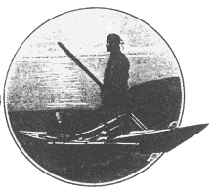

north."
This route is that taken by our American expeditions. Peary, Kane, and Hayes all used it. It always has been the easiest route as well as the most productive of natural food in seal and walrus. For our explorers it has been a hard trail. But for the Norwegian colonists whose forebears had spent 10 generations north of the arctic circle it must have been less difficult to travel than were the western plains for our American pioneers.
Lured Northward
Picture the terrible situation in which the deserted Norsemen in Greenland found themselves: No outlet for their trade. No source of supply for the little but indispensable luxuries of life. No access to friends and families back home. A generation - two, perhaps - of heartbreak
and of longing; unhappiness goading the younger men to travel northward.
Perhaps a route to southern lands lay that way. Suddenly like a bombshell
breaks upon the weary colony the wonderful news: "We've found a polar
paradise! Sunshine! Game! Grass! One moon's easy journey north! A short
lap on the sea ice! Come!"
What had they to
wait for? A Century had passed since the last ship sailed. The last man
who had seen a real Norwegian had died. The homeland was but a myth. So
they "packed and, singing songs, departed," the native legend puts it,
"suddenly to the northward." They never returned. The fact is not at all
surprising if what we think is true - that they found a land of milk and
honey in the very center of the polar pack. And it is perfectly logical to
suppose that their descendants will be found up there next summer by the
dirigible ZR-1, in dramatic isolation.
Hot springs and boiling mud are found in every part of Iceland. There has been projected an engineering scheme for heating the whole island by harnessing its steaming geysers.
In this connection it is interesting to compare the mean annual temperature of Iceland 34°F - with that of Greenland at the same latitude - minus 15° F. During the summer Icelanders enjoy a period quite comparable to that of our own New England states. Averages run up to 60° F.
